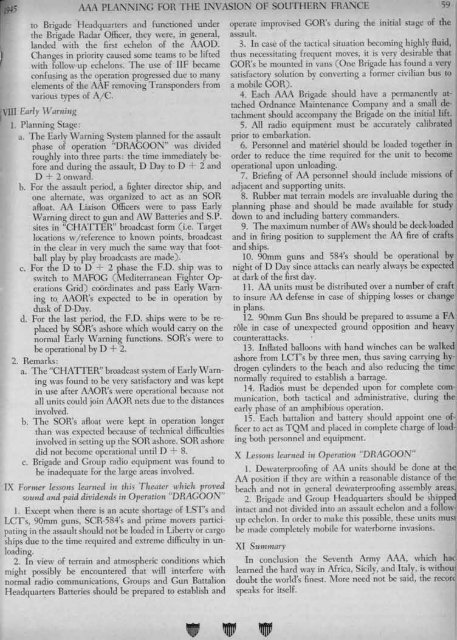September-October - Air Defense Artillery
September-October - Air Defense Artillery
September-October - Air Defense Artillery
Create successful ePaper yourself
Turn your PDF publications into a flip-book with our unique Google optimized e-Paper software.
45 AM PLANNING FOR THE INVASION OF SOUTHERN FHANCE 59<br />
to Brigade 'Headquarters and functioned under<br />
the Brigade Radar Officer, they were, in general,<br />
landed with the first echelon of the AAOD.<br />
Changes in priority caused some teams to be lifted<br />
with follow-up echelons. The use of IIF became<br />
confusing as the operation pr~gressed due to many<br />
elements of the AAF removing Transponders from<br />
various types of Aj8.<br />
VIII Early \Vanzillg<br />
1. Planning Stage:<br />
a. The Early \i\Tarning System planned for the assault<br />
phase of operation "DHAGOON" was divided<br />
roughly into three parts: the time immediately before<br />
and during the assault, D Day to D + 2 and<br />
D + 2 onward.<br />
b. For the assault period, a fighter director ship, and<br />
one alternate, was organized to act as an SOH.<br />
afloat. AA Liaison Officers were to pass Early<br />
Warning direct to gun and A\V Batteries and $.P.<br />
sites in "CHATTER" broadcast form (i.e. Target<br />
locations \\,/reference to known points, broadcast<br />
in the clear in very much the s~me way that football<br />
play by play broadcasts are made).<br />
c. For the D to D + 2 phase the F.D. ship was to<br />
switch to l\,IAFOG (Mediterranean Fighter Operations<br />
Grid) coordinates and pass Early \Varning<br />
to. AAOR's expected to be in operation by<br />
dusk of D-Dav.<br />
d.- For the last p~riod, the F.D. ships were to be replaced<br />
by SOH's ashore which would carry on the<br />
normal Early Warning functions. SOR's were to<br />
be operational by D + 2.<br />
2. Remarks:<br />
a. The "CHATTER" broadcast system of Early Warning<br />
was found to be very satisfactory and was kept<br />
in use after AAOR's were operational because not<br />
all units could join AAOR nets due to the distances<br />
involved.<br />
b. The SOR's afloat were kept in operation longer<br />
than was expected because of technical difficulties<br />
involved in setting up the SOR ashore. SOH ashore<br />
did not become operational until D + 8.<br />
c. Brigade and Group radio equipment was found to<br />
be inadequate for the large areas involved.<br />
IX Fonner lessons leanzed in this Theater which proved<br />
sound and paid dividends in Operation "DRAGOON"<br />
1. Except when there is an acute shortage of LST's and<br />
LCT's, 90mm guns, SCR-584's and prime movers participating<br />
in the assault should not be loaded in Liberty or cargo<br />
ships due to the time required and extreme difficulty in unloading<br />
..<br />
2. In view of terrain and atmospheric conditions which<br />
might possibly be encountered that will interfere with<br />
normal radio communications, Groups and Gun Battalion<br />
Headquart.ers Batteries should be prepared to establish and<br />
operate improvised GOH's during the initial stage of the<br />
assault.<br />
3. In case of the tactical situation becoming highly fluid,<br />
thus necessitating frequent moves, it is very desirable that<br />
GOR's be mounted in vans (One Brigade has found a very<br />
satisfactory solution by converting a former civilian bus to<br />
a mobile GOR).<br />
4. Each AAA Brigade should have a permanently attached<br />
Ordnance Maintenance Company and a small detachment<br />
should accompany the Brigade on the initial lift.<br />
5. All radio equipment must be accurately calibrated<br />
prior to embarkation.<br />
6. Personnel and materiel should be loaded together in<br />
order to reduce the time required for the unit to become<br />
operational upon unloading.<br />
7. Briefing of AA personnel should include missions of<br />
adjacent and supporting units.<br />
8. Rubber mat terrain models are invaluable during the<br />
planning phase and should be made available for study<br />
down to and including battery commanders.<br />
9. The maximum number of A\Vs should be deck-loaded<br />
and in firing position to supplement the AA fire of crafts<br />
and ships.<br />
10. 90mm guns and 584's should be operational by<br />
night of D Day since attacks can nearly always be expected<br />
at dark of the first day.<br />
11. AA units must be distributed over a number of craft<br />
to insu~e AA defense in case of shipping losses or change<br />
in plans.<br />
12. 90mm Gun Bns should be prepared to assume a FA<br />
role in case of une},.'pected ground opposition and heavy<br />
counterattacks.<br />
13. Inflated balloons with hand winches can be walked<br />
ashore from LCT's by three men, thus saving carrying hydrogen<br />
cylinders to the beach and also reducing the time<br />
normally required to establish a barrage.<br />
14. Radios must be depended upon for complete communication,<br />
both tactical and administrative, during the<br />
early phase of an amphibious operation.<br />
15. Each battalion and battery should appoint one officer<br />
to act as TQivl and placed in complete charge of loading<br />
both personnel and equipment.<br />
X Lessons learned in Operation "DRAGOON"<br />
1. Dewaterproofing of AA units should be done at the<br />
AA position if they are within a reasonable distance of the<br />
beach and not in general de\'vaterproofing assembly areas.<br />
2. Brigade and Group Headquarters should be shipped<br />
intact and not divided into an assault echelon and a followup<br />
echelon. In order to make this possible, these units must<br />
be made completely mobile for waterborne invasions.<br />
XI Summary<br />
In conclusion the Seventh Armv AAA, which hac<br />
learned the hard way in Africa, Sicily: and Italy, is withoUi<br />
doubt the world's finest. l\ilore need not be said, the recorc<br />
speaks for itself.
















